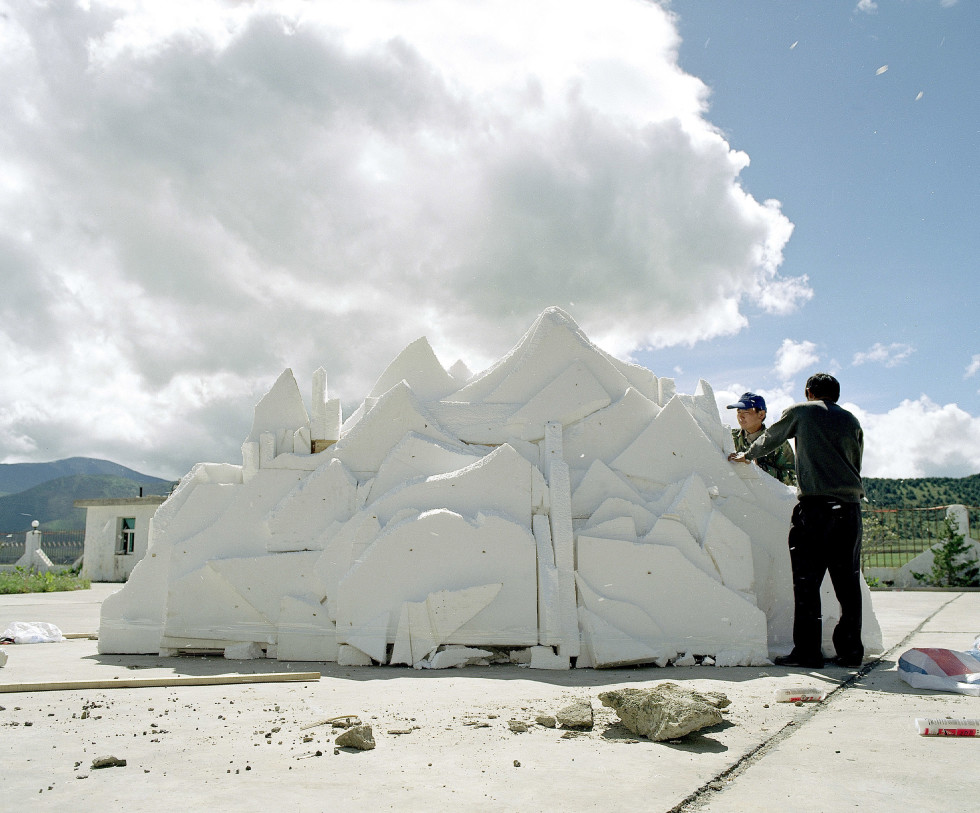
Patty Chang and David Kelley, 'Shangri-La' (Styrofoam Mountain), 2005 C-print, 20x24", Courtesy Kustera Tilton Gallery, New York
The 1st at Moderna: Patty Chang
Shangri-La - Document and Fiction
1.8 2006 – 27.8 2006
Stockholm
Patty Chang’s performances, documented in videos and photographs, often take the form of tests – for herself as well as for her audience. In Love (2001) sees herself, her father and her mother sharing a raw onion. They pass it from mouth to mouth, slowly eating it with tears streaming down their faces. The video runs in reverse time, creating an illusion of passionate kissing, only to reveal an onion emerging from their mouths.
In an interview, she said in regards to her performances, “I am always doing an Asian woman”, referring to how she uses Western stereotypes and fictions of Asia and Asians in her work. In Death of Game (2000) she re-enacts Bruce Lee’s part in an iconic fight scene from the 1978 martial arts movie Game of Death.
In Shangri-La, Patty Chang depicts a journey and the creation of an artwork. Shangri-La became a catch-phrase after James Hilton’s bestseller Lost Horizon was published in 1933. Frank Capra turned the novel into a successful movie in 1937. Lost Horizon is the story of a British diplomat whose aeroplane crashes in the Himalayas. He is rescued by monks who bring him to Shangri-La, an earthly paradise whose inhabitants enjoy longevity. Needless to say, James Hilton’s novel is a work of fiction. However, this fact did not stop the Chinese village Zhongdian from claiming to be the inspiration for Hilton’s Shangri-La – with the aim of attracting tourists. Zhongdian was soon followed by other Chinese villages purporting to be the real Shangri-La, thereby precipitating a marketing battle that came to be known as the “Shangri-La war.” The ensuing chaos eventually compelled the Chinese government to intervene and it ended the conflict by acknowledging Zhongdian as Shangri-La. The Chinese authorities may not have had a problem with falsifying history in this manner. History is often rewritten in order to serve the purpose of the powers that be. Even though it may not be the most pregnant of interpretations, Patty Chang’s film and photographs can be viewed as depictions of a China undergoing change, with its tourist industry erecting luxury hotels using extravagant props.
Patty Chang’s Shangri-La depicts a journey to Zhongdian, a real place dedicated to fiction. With the help of local people she created a sculpture, a kind of scale model, or a copy, of a local mountain. The fairly simple structure is covered by mirrors. The sculpture rotates slowly, “as a cross between a praying-wheel and a disco ball”, as the artist describes it. The work with the construction of the copy of the mountain, the practical arrangements and the cooperation with the local craftsmen become a model of the construction of Shangri-La. Mixing fiction, or construction, with reality is a recurring theme in Patty Chang’s work. The American curator and critic Russell Ferguson pays much attention to Patty Chang’s use of mirrors. In literature and art, mirrors often represent a passage between reality and a dream-world. Mirrors distort and dislocate reality. In art, mirrors also represent the void. In modern architecture, glass façades represent a new era of utopian ambitions. Mirrors reflect its environment but can themselves appear almost invisible, as spaces for fantasies, projections and desires. These and other meanings ascribed to mirrors are interesting in the art of Patty Chang.
In Shangri-La, she does not take centre stage but she nevertheless assumes the role of “The Asian Woman”, a stranger to Zhongdian, despite her Chinese origin. The connections to her performance art are not evident but still present. For example, she is photographed by local wedding photographers, who are trying to cash in on Zhongdian’s new status as Shangri-La. As in Patty Chang’s art, the photographers work in an area somewhere in between documentation, memory and fantasy.
Magnus af Petersens
Patty Chang
Born in 1972 in San Francisco. Lives and works in New York.
Education
1994
Bachelor of Arts, University of California, San Diego
Three solo exhibitions
2006
Fan Dance, Arratiabeer, Berlin
Patty Chang and David Kelley, Kustera
Tilton Gallery, New York
2005
Shangri-La, part of the Three M Project, UCLA
Hammer Museum, Los Angeles; New Museum of Contemporary Art, New York and Museum of Contemporary Art, Chicago
Three group exhibitions
2006
Still Points of the Turning World, Site Santa Fe Sixth International Biennial, Santa Fe
One Way or Another, The Asia Society, New York
LOVE!, curated by Andrea Salerno and Carmen Zita, Salvatore Ferragamo Gallery, New York
The 1st at Moderna is an exhibition programme for contemporary art. The opening is always on the first day of the month, and the exhibitions are in different venues in or outside the museum.
